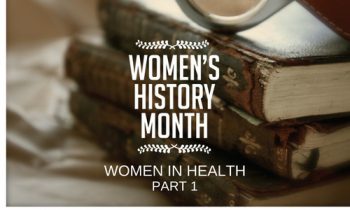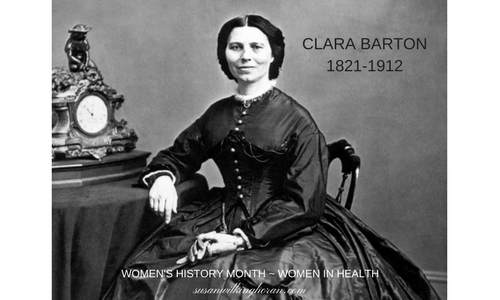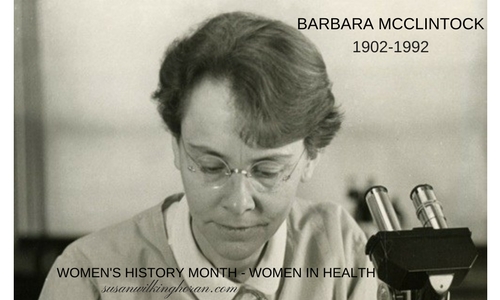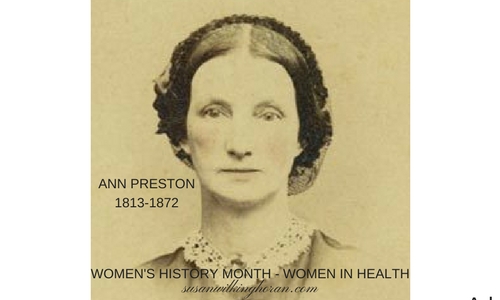HEROINES OF HISTORY AND HEALTH
 HELLO everyone and Welcome to #Factual Friday. March is WOMEN’S HISTORY MONTH. And, in Honor of women everywhere, I’ll be spending a lot of time this month Blogging and Posting about women in a Four-Part Series devoted to HEROINES IN HISTORY AND HEALTH.
HELLO everyone and Welcome to #Factual Friday. March is WOMEN’S HISTORY MONTH. And, in Honor of women everywhere, I’ll be spending a lot of time this month Blogging and Posting about women in a Four-Part Series devoted to HEROINES IN HISTORY AND HEALTH.
So, we begin our Salute to Incredible Women by profiling 3 who changed the way HEALTHCARE in AMERICA was perceived, practiced and delivered.
CLARA BARTON
Born on Christmas Day in 1821, Clara Barton spent most of her life in service to others. She became a teacher at the age of 15 and opened a Free Public School in New Jersey and later worked in the U.S. Patent Office as a clerk until the mid-1850s and the start of the Civil War.
This war changed the lives of every American and it was during this time Clara vouched to serve the needs of soldiers in any way she could. She collected and distributed supplies for the Union Army and served as an independent nurse – becoming known as “the Angel of the Battlefield.”
When the war ended in 1865, Clara worked for the War Department helping to reunite soldiers with families and locate the missing. She also worked with a relief organization in Europe known as the International Red Cross during the Franco-Prussian War of 1870 and committed herself to starting an American Branch of this organization.
To that end, Clara founded the American Red Cross in 1881 and served as its first president. Never taking a salary for her work, she used her funds to support a variety of relief efforts. She continued in her work in service to others until her death in 1912.
Today, the American Red Cross continues its humanitarian service to provide emergency assistance, disaster relief and educational programs for people in need throughout the United States. THANK YOU, CLARA BARTON.
 BARBARA McCLINTOCK
BARBARA McCLINTOCK
Born in 1902, Barbara McClintock was an American scientist and cytogeneticist. She received her PhD in botany from Cornell University in 1927 and became the leader in the development of “maize cytogenetics.”
She developed the technique for visualizing “maize chromosomes” and the ways in which these chromosomes changed during reproduction.
Her microscopic analysis became the foundation for numerous genetic theories and ideas – one of which was the notion of genetic recombination – targeting the cross-over process of genetic material during meiosis. In other words, Barbara discovered the mechanism by which chromosomes exchange genetic information.
Barbara mapped the first genetic maize, which linked regions of each chromosome to physical characteristics. She also demonstrated the role of the telomere and centromere regions of a chromosome that are so important to the sharing of genetic information – a process that became known as “genetic transposition.”
Barbara received numerous awards and fellowships throughout her career. She was elected a member of the National Academy of Sciences in 1944 and in 1983 became the first American woman to win an unshared Nobel Prize in Physiology and Medicine. At the time of her death in 1992, she was recognized as one of the most distinguished figures in science and medicine. THANK YOU, BARBARA McCLINTOCK.
ANN PRESTON
Born in 1813 in a Quaker community near Philadelphia, Pennsylvania Ann Preston was the second child of nine, and the only one of three daughters to survive into adulthood.
Dear family friend and famous Quaker minister Lucretia Mott was a great influence on Ann during her childhood years. In fact, with support from the Pennsylvania Quakers who encouraged women to enter the field of medicine, Ann became a medical apprentice under the tutelage of Dr. Nathaniel Moseley.
Years later, Ann enrolled in the first class of the Quaker founded Female Medical College of Pennsylvania from which she graduated in 1851 at the age of 38. After another year of post-graduate work, she began a series of lectures on female hygiene – and was appointed Professor of Physiology and Hygiene at the College.
And, from 1866 to 1872 Ann served as the Dean of the College, becoming the first woman Dean of an American Medical School – a position that allowed her to champion the rights of American women to enter medical schools and become physicians. Under her leadership, the College trained the first Native American and the first African American women doctors in America – and sent the first women medical missionaries to Asia.
Until her death in 1872, Ann devoted her life to the service of women in medicine. THANK YOU, ANN PRESTON.
________________________________________________________________
And, THANK YOU everyone for joining me. We’ll continue with this Series on HEROINES OF HISTORY AND HEALTH next Friday – and I hope to see you here again!
Until then, stay in GOOD HEALTH and . . .
TAKE THE COURSE AND TAKE CHARGE!



Wow I have not heard of any of these 3 women. They all have fascinatings stories xx
TY Suzie – Isn’t it just amazing to discover these women and their stories? 🙂
Very cool! In Social Studies students and I were talking about the 15th amendment; the girls were shocked discover that it took many more years later for women to vote.
Very impressive! I can’t wait to continue reading the series. 🙂
TY Natasha – Yes! We have fought a long and hard fight!
Great post and such inspiring stories! Didn’t know these women, thanks for sharing! 🙂
TY Patricia ~ I’m glad you enjoyed it 🙂